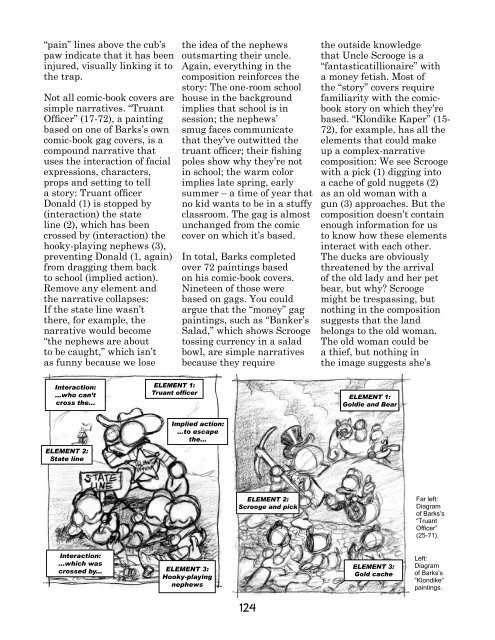Painting Fine-Art Cartoons in Oils - Enchanted Images
Painting Fine-Art Cartoons in Oils - Enchanted Images
Painting Fine-Art Cartoons in Oils - Enchanted Images
You also want an ePaper? Increase the reach of your titles
YUMPU automatically turns print PDFs into web optimized ePapers that Google loves.
“pa<strong>in</strong>” l<strong>in</strong>es above the cub’s<br />
paw <strong>in</strong>dicate that it has been<br />
<strong>in</strong>jured, visually l<strong>in</strong>k<strong>in</strong>g it to<br />
the trap.<br />
Not all comic-book covers are<br />
simple narratives. “Truant<br />
Officer” (17-72), a pa<strong>in</strong>t<strong>in</strong>g<br />
based on one of Barks’s own<br />
comic-book gag covers, is a<br />
compound narrative that<br />
uses the <strong>in</strong>teraction of facial<br />
expressions, characters,<br />
props and sett<strong>in</strong>g to tell<br />
a story: Truant officer<br />
Donald (1) is stopped by<br />
(<strong>in</strong>teraction) the state<br />
l<strong>in</strong>e (2), which has been<br />
crossed by (<strong>in</strong>teraction) the<br />
hooky-play<strong>in</strong>g nephews (3),<br />
prevent<strong>in</strong>g Donald (1, aga<strong>in</strong>)<br />
from dragg<strong>in</strong>g them back<br />
to school (implied action).<br />
Remove any element and<br />
the narrative collapses:<br />
If the state l<strong>in</strong>e wasn’t<br />
there, for example, the<br />
narrative would become<br />
“the nephews are about<br />
to be caught,” which isn’t<br />
as funny because we lose<br />
Interaction:<br />
...who can’t<br />
cross the...<br />
ELEMENT 2:<br />
State l<strong>in</strong>e<br />
Interaction:<br />
...which was<br />
crossed by...<br />
ELEMENT 1:<br />
Truant officer<br />
the idea of the nephews<br />
outsmart<strong>in</strong>g their uncle.<br />
Aga<strong>in</strong>, everyth<strong>in</strong>g <strong>in</strong> the<br />
composition re<strong>in</strong>forces the<br />
story: The one-room school<br />
house <strong>in</strong> the background<br />
implies that school is <strong>in</strong><br />
session; the nephews’<br />
smug faces communicate<br />
that they’ve outwitted the<br />
truant officer; their fish<strong>in</strong>g<br />
poles show why they’re not<br />
<strong>in</strong> school; the warm color<br />
implies late spr<strong>in</strong>g, early<br />
summer – a time of year that<br />
no kid wants to be <strong>in</strong> a stuffy<br />
classroom. The gag is almost<br />
unchanged from the comic<br />
cover on which it’s based.<br />
In total, Barks completed<br />
over 72 pa<strong>in</strong>t<strong>in</strong>gs based<br />
on his comic-book covers.<br />
N<strong>in</strong>eteen of those were<br />
based on gags. You could<br />
argue that the “money” gag<br />
pa<strong>in</strong>t<strong>in</strong>gs, such as “Banker’s<br />
Salad,” which shows Scrooge<br />
toss<strong>in</strong>g currency <strong>in</strong> a salad<br />
bowl, are simple narratives<br />
because they require<br />
Implied action:<br />
...to escape<br />
the...<br />
ELEMENT 3:<br />
Hooky-play<strong>in</strong>g<br />
nephews<br />
ELEMENT 2:<br />
Scrooge and pick<br />
124<br />
the outside knowledge<br />
that Uncle Scrooge is a<br />
“fantasticatillionaire” with<br />
a money fetish. Most of<br />
the “story” covers require<br />
familiarity with the comicbook<br />
story on which they’re<br />
based. “Klondike Kaper” (15-<br />
72), for example, has all the<br />
elements that could make<br />
up a complex-narrative<br />
composition: We see Scrooge<br />
with a pick (1) digg<strong>in</strong>g <strong>in</strong>to<br />
a cache of gold nuggets (2)<br />
as an old woman with a<br />
gun (3) approaches. But the<br />
composition doesn’t conta<strong>in</strong><br />
enough <strong>in</strong>formation for us<br />
to know how these elements<br />
<strong>in</strong>teract with each other.<br />
The ducks are obviously<br />
threatened by the arrival<br />
of the old lady and her pet<br />
bear, but why? Scrooge<br />
might be trespass<strong>in</strong>g, but<br />
noth<strong>in</strong>g <strong>in</strong> the composition<br />
suggests that the land<br />
belongs to the old woman.<br />
The old woman could be<br />
a thief, but noth<strong>in</strong>g <strong>in</strong><br />
the image suggests she’s<br />
ELEMENT 1:<br />
Goldie and Bear<br />
ELEMENT 3:<br />
Gold cache<br />
Far left:<br />
Diagram<br />
of Barks’s<br />
“Truant<br />
Officer”<br />
(25-71).<br />
Left:<br />
Diagram<br />
of Barks’s<br />
“Klondike”<br />
pa<strong>in</strong>t<strong>in</strong>gs.


